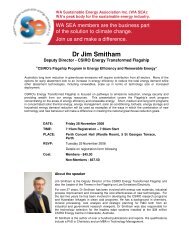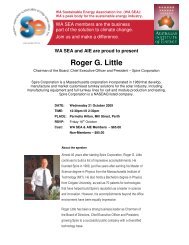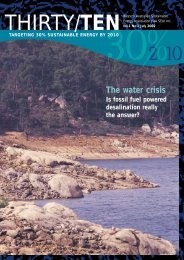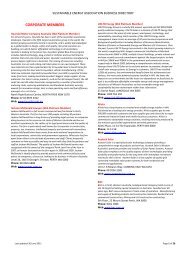THIRTY/TEN
Volume 2 No2 - June 2003 - SEA
Volume 2 No2 - June 2003 - SEA
- No tags were found...
Create successful ePaper yourself
Turn your PDF publications into a flip-book with our unique Google optimized e-Paper software.
Carnegie to Generate Energy From Wave<br />
Power in Agreement with Pacific Hydro<br />
<strong>THIRTY</strong>/<strong>TEN</strong><br />
Renewable energy company Pacific<br />
Hydro, is buying into and advancing a<br />
renewable energy generator to produce<br />
electricity from wave power that<br />
Carnegie Corporation has been<br />
developing in Fremantle.<br />
This is part of a highly significant dual endorsement<br />
for the Seapower project and for Carnegie, with<br />
Pacific Hydro bringing in new expertise and strategic<br />
financial support.<br />
Combined with strong support from the<br />
Commonwealth Government, which is also injecting<br />
$600,000 as part of an R&D Start Grant offered by<br />
AusIndustry, the project now has in place the<br />
necessary funding for the construction and<br />
deployment of the first large-scale prototype.<br />
Carnegie’s Managing Director Alan Hopkins said the<br />
development of the first large-scale wave energy<br />
generator was already underway in Fremantle with<br />
in-sea trials now scheduled to commence early 2004.<br />
“The relationship with Pacific Hydro (already the<br />
operator of 40% of Australia’s wind energy capacity)<br />
is very promising for wave energy technology,” he<br />
said. “For Carnegie it means we reap the benefits<br />
from development work to date and while continuing<br />
to provide technical support to the development<br />
program, we have limited financial exposure to the<br />
development process going forward and in future<br />
have a potentially large revenue stream from<br />
electricity generated by wave energy.”<br />
Under the agreement with Carnegie, Pacific Hydro<br />
has exclusive rights to develop and operate<br />
commercial wave units over 5MW in capacity. And<br />
the company will earn royalties from these larger<br />
units plus retain the rights to build small-scale<br />
power units less than 5MW for all areas of the world<br />
south of 10 degrees North latitude. This size of unit<br />
is considered ideal for many islands and remote<br />
communities.<br />
The wave energy generator technology is designed<br />
to economically produce pollution-free electricity<br />
Alan Burns (seated) with Alan Hopkins<br />
and desalinated water. It has been under joint<br />
development in Fremantle by Carnegie and the<br />
research and development group of Alan Burns,<br />
(Chairman of Carnegie).<br />
Seapower Pacific Pty Ltd is a joint venture between<br />
Pacific Hydro, Carnegie Corporation and Seapower<br />
Pty Ltd.<br />
Further information:<br />
Alan Hopkins, Carnegie Corporation 9486 4466<br />
Wave energy and the Seapower system<br />
The World Energy Council has estimated global wave resources<br />
contain twice the world’s current energy consumption.<br />
Research to harness this resource is increasing in response to<br />
global warming caused largely by burning fossil fuels for energy<br />
generation.<br />
The Seapower Pacific system is a submerged, near shore device<br />
on the seabed producing highly pressurised seawater. Hydraulic<br />
converters and generators convert the energy to electricity<br />
without the need for undersea grids or expensive marine<br />
qualified plant. The system also produces substantial fresh water<br />
via reverse osmosis desalination, by directly tapping the<br />
pressurised seawater.<br />
Standard units deliver approximately 2.4 MW of power on shore<br />
and 0.57 gigalitre/year of desalinated water (both at 80%<br />
availability). An array of 40 of these units could produce 100MW<br />
of electricity and approx 22 gigalitres/yr of drinking water.<br />
The construction materials are concrete, rubber and steel, all<br />
with proven longevity in sub-sea conditions. The system is<br />
immune to storm destruction, and is self-tuning to tide, sea state<br />
and wave amplitude.<br />
Solar Pre-Heating Saves Money On Fuel<br />
The Swan River paddle steamer “Decoy”<br />
is a replica of the original ship of 1878,<br />
built from the original plans in 1986. The<br />
ship is used as a charter pleasure craft,<br />
moored at Mends St jetty. But instead of<br />
using diesel as the exclusive fuel to fire<br />
the boiler, the “Decoy” has a pre-heater<br />
system using eight solar panels.<br />
Paddle steamers were common in Australia at the<br />
turn of the last century as ideal transportation on the<br />
Swan River because of their shallow draft. They burnt<br />
wood which was in abundance, but they were slow.<br />
The engine in the present vessel is the original two<br />
cylinder Ransomes. Typical of a steam powered ship,<br />
a large area amidships is taken up with the engine<br />
and steam boiler. Passengers can watch the action.<br />
From its construction in 1986, the replica “Decoy”<br />
has always used diesel, both to power its steam<br />
engine, and to run an auxiliary diesel generator. The<br />
diesel for the steam boiler is burnt directly, not like a<br />
conventional compression diesel engine. For that<br />
reason, the only visible emission from the funnel is<br />
steam.<br />
The addition of the solar panels came about because<br />
the owner wanted to reduce boiler start-up costs,<br />
and with the ship always moored facing north, the<br />
obvious choice was solar water heater collector<br />
panels. These are situated on the roof of the main aft<br />
saloon. The panels act as pre-heaters and have<br />
reduced diesel costs by 80% whilst steaming up. On<br />
sunny days the panels provide input when underway.<br />
The solar panels were donated by Solahart.<br />
More information about the “Decoy” 9470 1727<br />
11






